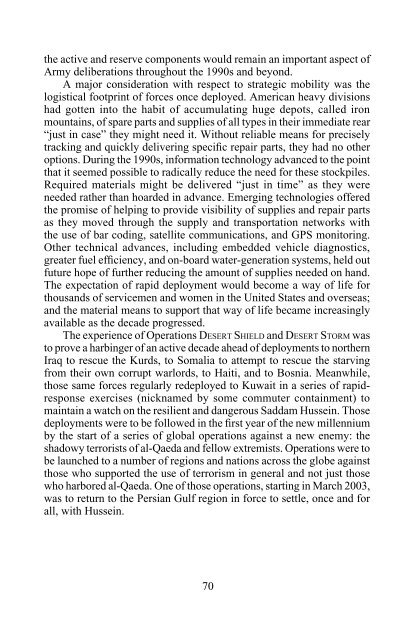$26 million went to Sea Emergency Deployment Readiness Exercises(SEDREs) wherein combat units raced to port, loaded themselves ontoships, and deployed into a training event featuring some combinationof amphibious, over-the-shore, and through-port entry into a selectedbattlefield. National Training Center scenarios began featuring a speedytactical draw of vehicles and equipment such as might be the case whenmarrying troops with hardware previously shipped or pre-positioned. Bythe mid-1990s, rotations to draw battalion sets of equipment in Kuwaitand then train in the Kuwaiti desert offered further expeditionary trainingas part of the long and drawn-out campaign to contain the still-standingSaddam Hussein. The Army was preparing itself to be an agile andpowerful expeditionary force.The disposition of pre-positioned equipment for U.S.-based unitsadjusted to the new realities. During the Cold War, such equipment hadbeen stockpiled in division sets in Germany and the Benelux countries.In annual Reforger exercises, troops from the United States flew toEurope, drew and manned that equipment, and rolled out to training areas,thus demonstrating their capability to rapidly reinforce NATO. Duringthe 1990s, this capability dispersed more broadly, with a total of eightbrigade sets spread through Europe, Korea, Kuwait, Qatar, and afloat.The set of equipment pre-positioned afloat in the Indian Ocean offeredthe most flexibility. It consisted of a brigade set of two armored and twomechanized infantry battalions with a thirty-day supply of food, fuel, andammunition aboard sixteen ships, of which seven were roll-on/roll-off.Collectively considered, the sets in Kuwait, Qatar, and afloat could havepositioned a heavy division into the Persian Gulf in days rather than themonth plus of Desert Shield. By the mid-1990s, the expeditionary intentof the Army proposed a capability to deploy five-and-a-third divisionsinto a theater of war within seventy-five days.Deployment on such a scale would require reliance on the reservecomponent as never before. The post-Vietnam force structure had locatedmajor elements of the combat support and combat service support uponwhich the active component depended in the Reserves and NationalGuard. During Desert Storm, when active-duty strength was 728,000;that of the Reserves 335,000; and the National Guard 458,000, 39,000Reservists and 37,000 National Guardsmen were called up to supporta total force of 297,000 deployed to Southwest Asia. With the activeforce reduced to 529,000 and still falling in 1994, and the Army budgetdecreased from $77.7 billion in 1990 to $63.5 billion in 1994, relianceon the reserve component early on during major deployments becameeven more critical. The relative size, composition, balance, and roles of69
the active and reserve components would remain an important aspect ofArmy deliberations throughout the 1990s and beyond.A major consideration with respect to strategic mobility was thelogistical footprint of forces once deployed. American heavy divisionshad gotten into the habit of accumulating huge depots, called ironmountains, of spare parts and supplies of all types in their immediate rear“just in case” they might need it. Without reliable means for preciselytracking and quickly delivering specific repair parts, they had no otheroptions. During the 1990s, information technology advanced to the pointthat it seemed possible to radically reduce the need for these stockpiles.Required materials might be delivered “just in time” as they wereneeded rather than hoarded in advance. Emerging technologies offeredthe promise of helping to provide visibility of supplies and repair partsas they moved through the supply and transportation networks withthe use of bar coding, satellite communications, and GPS monitoring.Other technical advances, including embedded vehicle diagnostics,greater fuel efficiency, and on-board water-generation systems, held outfuture hope of further reducing the amount of supplies needed on hand.The expectation of rapid deployment would become a way of life forthousands of servicemen and women in the United States and overseas;and the material means to support that way of life became increasinglyavailable as the decade progressed.The experience of Operations Desert Shield and Desert Storm wasto prove a harbinger of an active decade ahead of deployments to northernIraq to rescue the Kurds, to Somalia to attempt to rescue the starvingfrom their own corrupt warlords, to Haiti, and to Bosnia. Meanwhile,those same forces regularly redeployed to Kuwait in a series of rapidresponseexercises (nicknamed by some commuter containment) tomaintain a watch on the resilient and dangerous Saddam Hussein. Thosedeployments were to be followed in the first year of the new millenniumby the start of a series of global operations against a new enemy: theshadowy terrorists of al-Qaeda and fellow extremists. Operations were tobe launched to a number of regions and nations across the globe againstthose who supported the use of terrorism in general and not just thosewho harbored al-Qaeda. One of those operations, starting in March 2003,was to return to the Persian Gulf region in force to settle, once and forall, with Hussein.<strong>70</strong>












